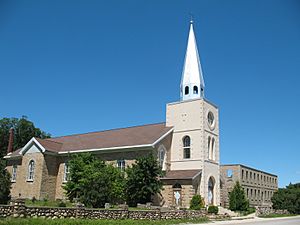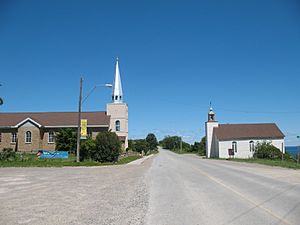Holy Cross Church (Wiikwemkoong) facts for kids
Quick facts for kids Holy Cross Church |
|
|---|---|

Church entrance with the mission ruins in the background
|
|
| 45°48′29″N 81°42′40″W / 45.808173°N 81.711237°W | |
| Location | Wiikwemkoong First Nation |
| Country | Canada |
| Denomination | Roman Catholic |
| History | |
| Status | Active |
| Founded | 1838 |
| Founder(s) | Society of Jesus |
| Dedication | Feast of the Cross |
| Events | Interior burnt in 1954 |
| Architecture | |
| Functional status | Parish church |
| Architect(s) | Fr. Nicholas Point, S.J. |
| Groundbreaking | 31 July 1849 |
| Completed | 25 July 1852 |
| Administration | |
| Diocese | Sault Sainte Marie |
| Province | Kingston |
Holy Cross Church is a Roman Catholic church located in the Wiikwemkoong First Nation on Manitoulin island in Canada. It was started by a group called the Society of Jesus (Jesuits) in 1844. This was their first mission in Northern Ontario after they had been stopped from working for a while.
The mission was very important for helping people learn to read and write the Ojibwe language in Canada. The church building you see today was finished in 1852. It stands north of Wiikwemkoong on Wikwemikong Way, right next to the Giizhigaanang Community Centre.
Contents
History of the Church
Starting the Mission
The first European known to visit Manitoulin Island was a Jesuit priest, Father Joseph Poncet, in 1648. However, no one stayed to keep a European presence on the island. After the War of 1812, the Odawa, Ojibwe, and Potawatomi tribes moved to the island. More First Nation people also came after the Treaty of Washington in 1836.
In 1838, a Catholic priest named Father Jean-Baptiste Proulx was asked to come to the island. He came to serve the local Catholic community. This marked the first Jesuit mission in Northern Ontario in the 1800s. Father Proulx left in 1845, and the Jesuits continued his work. They built a school, a place to live, a sawmill, and a farm training center for the local people.
The Jesuits working in Wiikwemkoong learned the Ojibwe language. They then taught young people how to write it. This exchange of skills and languages was very important. The Nishnaabeg people of Manitoulin Island began writing in Ojibwe. They used it for religious topics, personal letters, and political messages. This helped many people for different reasons.
During the 1800s, most written Ojibwe texts were created by non-Native people. These were often missionaries and language experts, like the Jesuits. This led to a growing movement of Nishnaabe people learning to read and write.
Building the Church
In 1848, plans were made to build a permanent church. One of the Jesuits, Father Nicholas Point, was an architect. He designed the church building. The first stone of the church was placed on July 31, 1849. It was built using strong limestone bricks. Local people did the construction work.
The building was finished almost three years later. The church officially opened on July 25, 1852. Later, in 1899, the church steeple was added.
Rebuilding After a Fire
In 1954, both the church and the building next to it were damaged by a fire. The inside of the church was burned, but it was rebuilt. The residence next door was much more severely damaged. That building had to be left empty. Its interior was removed, leaving only the outer walls.
In 1988, a TV show called People Patterns from TVOntario featured Holy Cross. It was part of a story about Manitoulin Island and its people.
Mission Ruins and Theatre
Since 1994, the ruins of the residence next to the church have been used by the De-ba-jeh-mu-jig Theatre Group. This is the longest-running professional Indigenous theatre company in North America. Every summer, from July to August, the theatre group uses the empty space within the old walls as a stage. Their first play there was The Manitoulin Incident.
During the Good Friday Mass, the theatre group performs a play about the Passion of Christ. They do this for the church community inside the Holy Cross Mission Church.
In 2016, the ruins were used as a background for a music video. It was for the song "Pray, Sister Pray" by Crystal Shawanda. The video was nominated at the 41st American Indian Film Festival.
See also
- Anishinabe Spiritual Centre
- List of Jesuit sites


